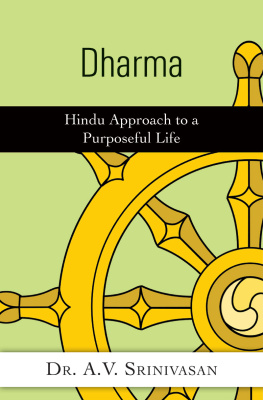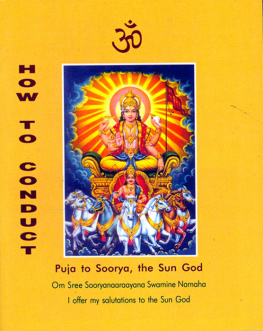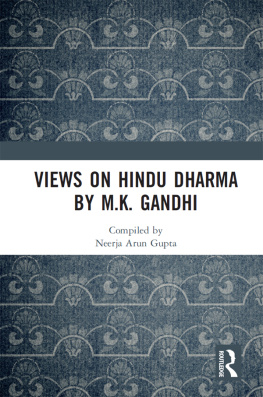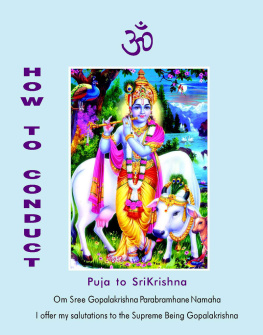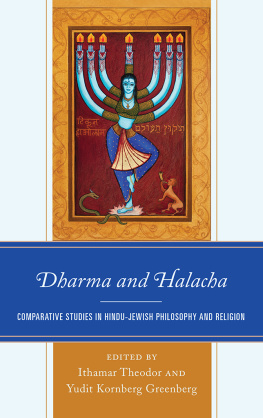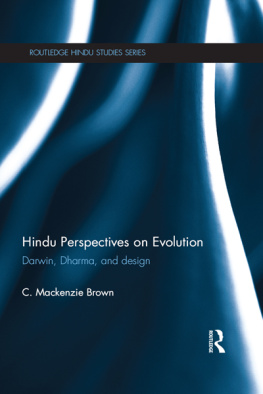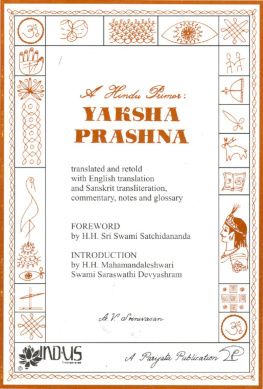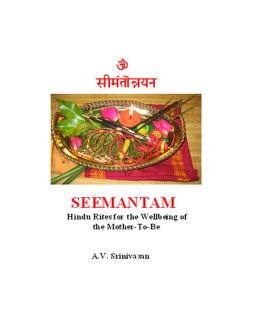Dr. A. V. Srinivasan - Dharma: Hindu Approach to a Purposeful Life
Here you can read online Dr. A. V. Srinivasan - Dharma: Hindu Approach to a Purposeful Life full text of the book (entire story) in english for free. Download pdf and epub, get meaning, cover and reviews about this ebook. year: 2012, publisher: Dr. A. V. Srinivasan, genre: Religion. Description of the work, (preface) as well as reviews are available. Best literature library LitArk.com created for fans of good reading and offers a wide selection of genres:
Romance novel
Science fiction
Adventure
Detective
Science
History
Home and family
Prose
Art
Politics
Computer
Non-fiction
Religion
Business
Children
Humor
Choose a favorite category and find really read worthwhile books. Enjoy immersion in the world of imagination, feel the emotions of the characters or learn something new for yourself, make an fascinating discovery.
- Book:Dharma: Hindu Approach to a Purposeful Life
- Author:
- Publisher:Dr. A. V. Srinivasan
- Genre:
- Year:2012
- Rating:3 / 5
- Favourites:Add to favourites
- Your mark:
- 60
- 1
- 2
- 3
- 4
- 5
Dharma: Hindu Approach to a Purposeful Life: summary, description and annotation
We offer to read an annotation, description, summary or preface (depends on what the author of the book "Dharma: Hindu Approach to a Purposeful Life" wrote himself). If you haven't found the necessary information about the book — write in the comments, we will try to find it.
Dr. A. V. Srinivasan: author's other books
Who wrote Dharma: Hindu Approach to a Purposeful Life? Find out the surname, the name of the author of the book and a list of all author's works by series.
Dharma: Hindu Approach to a Purposeful Life — read online for free the complete book (whole text) full work
Below is the text of the book, divided by pages. System saving the place of the last page read, allows you to conveniently read the book "Dharma: Hindu Approach to a Purposeful Life" online for free, without having to search again every time where you left off. Put a bookmark, and you can go to the page where you finished reading at any time.
Font size:
Interval:
Bookmark:

Other ebooks by the author
Puja Booklet Series
How to Conduct Puja
in the privacy of your own home in America
and in the company of your family and friends
How to Conduct Puja to Soorya
How to Conduct Puja to Shiva
How to Conduct Puja to Ramachandra
How to Conduct Puja to SriKrishna
How to Conduct Puja to MahaGanapati
How to Conduct Puja to Goddess Saraswati
How to Conduct Puja to Durgadevi
How to Conduct Puja to Mahalakshmi
How to Conduct Puja to The Navagrahas (print version only)
A Hindu Primer: Yaksha Prashna
Available in print from Amazon.com, Abebooks.com and as ebooks wherever ebooks are sold.
A complete list of all books and a selection of papers are appended at the end of this booklet.
Dharma: Hindu Approach to a Purposeful Life
By
Dr. A. V. Srinivasan
DEDICATION
This Booklet is written for the use of
young Hindus and their families
practicing their heritage
in North America
A. V. Srinivasan; Periplus Line LLC, 2013
No part of this ebook may be reproduced in any form without prior written permission from the publisher, Parijata Publications c/o Periplus Line LLC, Box 56, East Glastonbury, CT 06025-0056 U.S.A. www.periplusline.com
ISBN: 978-1-62209-672-5
Parijata Publications is an imprint of Periplus Line LLC
Dharma: Hindu Approach to a Purposeful Life

kshudram hridayadaurbalyam tyaktvottishtha paramtapa.
Cast off this mean weakness of heart. Stand up, Arjuna
Bhagavadgita (II-3)
Foreword by Dr. Phillip Wagoner
A Parijata Publication
2013
If pressed to identify what lies at the heart of Hinduism, many Hindus would be quick to assert that it is dharma, the virtuous action that sustains the harmonious functioning of human society and upholds the very order of the cosmos itself. But how is one to know what constitutes proper dharmic behavior in any given situation? This is a much more difficult question and one that has given pause even to some of the most prominent figures in the Hindu tradition. As the ancient sage Apastamba has said, Dharma and adharma do not go around saying Here we are! Neither do the gods, gandharvas, or ancestors tell us this is right, this is wrong. (Na dharmdharmau carata vam sva iti. Na devagandharv na pitara itycakate yam dharmo yam adharma iti;pastamba Dharma Stra 1.20.6). Dharma is indeed a subtle and elusive concept, and it demands careful and sustained examination before one can be confident of applying it correctly in daily life.
Dr. A.V. Srinivasan has written this thoughtful essay on dharma in response to the particular needs of young Hindus living in North America. Located half the world away from the support provided by social and religious institutions in India, many naturally thirst for authoritative information about their religious heritage as well as for practically oriented guidance for daily practice. To them I highly recommend this very personal and engaging meditation on dharma, which happily takes its place alongside Dr. Srinivasans other important works on puja and the Vedic Wedding ceremony. It is a work that will amply repay repeated reading and contemplation.
Phillip B. Wagoner
Wesleyan University
Middletown, Connecticut
I.
What is the purpose of life?
Do you ever think about it? Sooner or later you might! As you may correctly guess, this question, in a variety of ways, has been asked over centuries and millions of times. The answers, also in a variety of forms, have also been offered, discussed and debated as long and as many times. However the dialogue must continue because, as a fundamental question, it has many dimensions and so is the answer.
A recent contribution to this vexing query came from a scholar, former President of India Dr. Sarvepalli Radhakrishnan. He stated eloquently that the Hindu view of life is an attempt to discover the ideal possibilities of human life. The concept of dharma is at the very core of such discovery and the Hindu code of behavior serves as a basis towards such attempts. What role does this concept play in the normal life of Hindus?
Let us look at a familiar ritual in which dharma is invoked: Hindu wedding. At a certain point during the ceremony, the priest instructs the father of the bride to charge the groom as follows: Do not cross the boundaries of dharma, artha and kama (dharmecharthecha kamecha naati charitaa tvameyam). To which the groom is advised to respond: I shall not cross the boundaries (naati charaami). It is assumed (not likely to be a valid assumption!) that all the principals gathered at the wedding mantap (stage) and the entire assembly understand the import of this charge by the giver of the bride and the commitment by the groom, the receiver. And the ceremony is allowed to proceed.
What are these boundaries? Who defines them? Who sets them? What are these three attributes dharma, artha and kama? This booklet will explore these concepts with specific emphasis on the concept of dharma that has served as the beacon of hope guiding the lives of Hindus over millennia.
Dharma is the first of four personal aims to be realized or striven for during the course of ones lifetime known as chaturvidha phala purushaartha, i.e. dharma, artha, kama and moksha. Let us first simply define the less elusive aims of artha and kama, and then accept a simple definition of moksha, the primary goal of Hindus, before we proceed to define and delve deeper into dharma.
Artha implies wealth, statecraft, and the elements of a material life. Kama involves sensory, emotional and aesthetic fulfillment. Moksha is liberation and salvation. So the Hindu says that it is a householders obligation to practice artha and kama with dharma as the boundary so that the primary object of reaching salvation and a release from cycles of rebirth may be achieved. Clearly happiness, prosperity, and the good life are considered to be legitimate human experiences as long as they are reached within the constraints of dharma. If moksha is our goal, the ancient Hindus said, then by all means participate fully in the affairs of society, raise a family, enjoy the good life, serve the community ... all within the framework known as dharma.
The word dharma is formed from the root dhr and literally means to hold, sustain and maintain a thing in its being, leading to harmony and balance in nature. Prthiveem dharmana dhrtam (The earth is upheld by dharma) declares the Atharva Veda (XII 1.17). This is elaborated further in the verse:
satyam brhad rtam ugram deekshaa tapo
brahma yagnaha prthiveem dhaarayanti
Atharva Veda (XII 1.1)
Truth, eternal order that is great and stern
consecration, austerity, prayer and ritual these uphold the earth.
We may begin to have a glimpse of its vast scope by translating dharma as right action, right conduct, virtue, moral law, etc. Every form of life, every group of people has its dharma, which is the law of its being. Dharma or virtue is conformity with the truth of things; adharma or vice is its opposite. Sage Kanada, proponent of the Vaisheshika Darshana (see page 298 of my book Hinduism for Dummies for details of Darshana Schools) postulates dharma as follows: Dharma is that practice from which both worldly wellbeing as well as supreme blessedness are obtained during ones lifetime (yato abhyudaya nishreyasiddhi: sa dharma:)
Next pageFont size:
Interval:
Bookmark:
Similar books «Dharma: Hindu Approach to a Purposeful Life»
Look at similar books to Dharma: Hindu Approach to a Purposeful Life. We have selected literature similar in name and meaning in the hope of providing readers with more options to find new, interesting, not yet read works.
Discussion, reviews of the book Dharma: Hindu Approach to a Purposeful Life and just readers' own opinions. Leave your comments, write what you think about the work, its meaning or the main characters. Specify what exactly you liked and what you didn't like, and why you think so.

